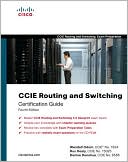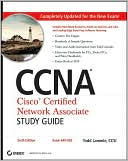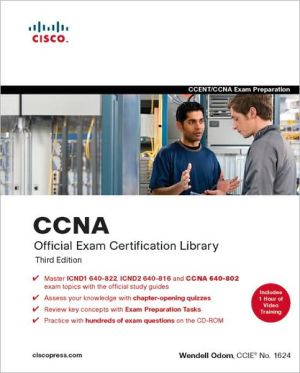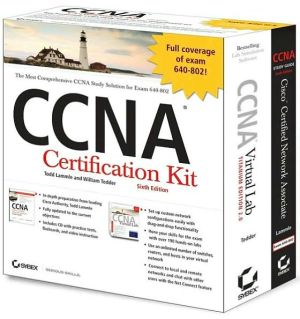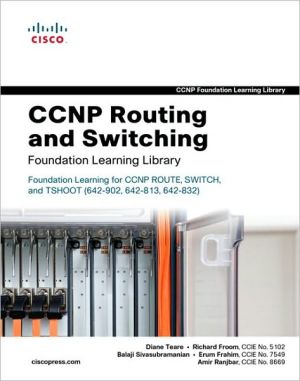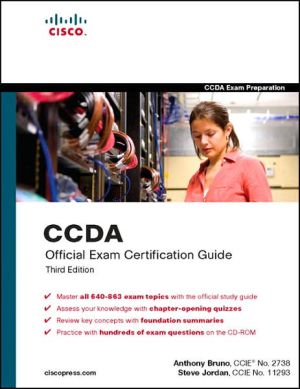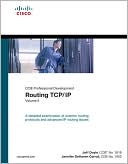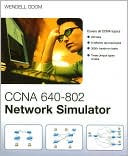CCIE Routing and Switching Certification Guide (Exam Certification Guide Series)
Search in google:
Master CCIE Routing and Switching 4.0 blueprint exam topics Assess your knowledge with chapter-opening quizzes Review key concepts with Exam Preparation Tasks Practice with realistic exam questions on the CD-ROMCCIE Routing and Switching Certification Guide, Fourth Edition, is a best-of-breed Cisco® exam study guide that focuses specifically on the objectives for the CCIE® Routing and Switching written exam. Well-respected networking professionals Wendell Odom, Rus Healy, and Denise Donohue share preparation hints and test-taking tips, helping you identify areas of weakness and improve both your conceptual knowledge and hands-on skills. Material is presented in a concise manner, focusing on increasing your understanding and retention of exam topics.CCIE Routing and Switching Certification Guide, Fourth Edition, presents you with an organized test preparation routine through the use of proven series elements and techniques. “Do I Know This Already?” quizzes open each chapter and allow you to decide how much time you need to spend on each section. Exam topic lists make referencing easy. Chapter-ending Exam Preparation Tasks sections help drill you on key concepts you must know thoroughly.The companion CD-ROM contains a powerful testing engine that allows you to focus on individual topic areas or take complete, timed exams. The assessment engine also tracks your performance and provides feedback on a module-by-module basis, presenting question-by-question remediation to the text and laying out a complete study plan for review.Well regarded for its level of detail, assessment features, and challenging review questions and exercises, this official study guide helps you master the concepts and techniques that will enable you to succeed on the exam the first time. CCIE Routing and Switching Certification Guide, Fourth Edition, is part of a recommended learning path from Cisco that includes simulation and hands-on training from authorized Cisco Learning Partners and self-study products from Cisco Press. To find out more about instructor-led training, e-learning, and hands-on instruction offered by authorized Cisco Learning Partners worldwide, please visit www.cisco.com/go/authorizedtraining.The official study guide helps you master all the topics on the CCIE Routing and Switching written exam, including: Bridging and LAN switching IP addressing, IP services, TCP, UDP, and application protocol details Layer 3 forwarding concepts EIGRP, OSPF, and BGP routing protocols Quality of service Frame Relay MPLS IP multicast IPv6 Router and switch security TroubleshootingCompanion CD-ROMThe CD-ROM contains 200 practice questions for the exam.This volume is part of the Certification Guide Series from Cisco Press®. Books in this series provide officially developed exam preparation materials that offer assessment, review, and practice to help Cisco Career Certification candidates identify weaknesses, concentratetheir study efforts, and enhance their confidence as exam day nears.Category: Cisco Press–Cisco CertificationCovers: CCIE Routing and Switching written exam 350-001 v4.0
Foreword xxxiIntroduction xxxiiPart I LAN SwitchingChapter 1 Ethernet Basics 3“Do I Know This Already?” Quiz 3Foundation TopicsEthernet Layer 1: Wiring, Speed, and Duplex 7RJ-45 Pinouts and Category 5 Wiring 7Auto-negotiation, Speed, and Duplex 8CSMA/CD 9Collision Domains and Switch Buffering 9Basic Switch Port Configuration 11Ethernet Layer 2: Framing and Addressing 13Types of Ethernet Addresses 15Ethernet Address Formats 16Protocol Types and the 802.3 Length Field 17Switching and Bridging Logic 18SPAN and RSPAN 20Core Concepts of SPAN and RSPAN 22Restrictions and Conditions 22Basic SPAN Configuration 24Complex SPAN Configuration 24RSPAN Configuration 25Foundation SummaryMemory Builders 29Fill In Key Tables from Memory 29Definitions 29Further Reading 29Chapter 2 Virtual LANs and VLAN Trunking 31“Do I Know This Already?” Quiz 31Foundation TopicsVirtual LANs 35VLAN Configuration 35Using VLAN Database Mode to Create VLANs 36Using Configuration Mode to Put Interfaces into VLANs 38Using Configuration Mode to Create VLANs 39Private VLANs 40VLAN Trunking Protocol 42VTP Process and Revision Numbers 43VTP Configuration 44Normal-Range and Extended-Range VLANs 46Storing VLAN Configuration 47VLAN Trunking: ISL and 802.1Q 48ISL and 802.1Q Concepts 48ISL and 802.1Q Configuration 49Allowed, Active, and Pruned VLANs 52Trunk Configuration Compatibility 52Configuring Trunking on Routers 53802.1Q-in-Q Tunneling 55Configuring PPPoE 56Foundation SummaryMemory Builders 60Fill In Key Tables from Memory 61Definitions 61Further Reading 61Chapter 3 Spanning Tree Protocol 63“Do I Know This Already?” Quiz 63Foundation Topics802.1d Spanning Tree Protocol 67Choosing Which Ports Forward: Choosing RootPorts and Designated Ports 67Electing a Root Switch 67Determining the Root Port 69Determining the Designated Port 70Converging to a New STP Topology 71Topology Change Notification and Updating the CAM 72Transitioning from Blocking to Forwarding 73Per-VLAN Spanning Tree and STP over Trunks 74STP Configuration and Analysis 76Optimizing Spanning Tree 79PortFast, UplinkFast, and BackboneFast 79PortFast 80UplinkFast 80BackboneFast 81PortFast, UplinkFast, and BackboneFast Configuration 81PortChannels 82Load Balancing Across PortChannels 82PortChannel Discovery and Configuration 83Rapid Spanning Tree Protocol 84Rapid Per-VLAN Spanning Tree Plus (RPVST+) 86Multiple Spanning Trees: IEEE 802.1s 87Protecting STP 88Root Guard and BPDU Guard: Protecting Access Ports 89UDLD and Loop Guard: Protecting Trunks 89Troubleshooting Complex Layer 2 Issues 91Layer 2 Troubleshooting Process 91Layer 2 Protocol Troubleshooting and Commands 92Troubleshooting Using Basic Interface Statistics 92Troubleshooting Spanning Tree Protocol 95Troubleshooting Trunking 95Troubleshooting VTP 96Troubleshooting EtherChannels 98Approaches to Resolving Layer 2 Issues 100Foundation SummaryMemory Builders 103Fill in Key Tables from Memory 103Definitions 103Further Reading 103Part II IPChapter 4 P Addressing 105“Do I Know This Already?” Quiz 105Foundation TopicsIP Addressing and Subnetting 108IP Addressing and Subnetting Review 108Subnetting a Classful Network Number 109Comments on Classless Addressing 111Subnetting Math 111Dissecting the Component Parts of an IP Address 111Finding Subnet Numbers and Valid Range of IP Addresses–Binary 112Decimal Shortcuts to Find the Subnet Number and Valid Range of IPAddresses 113Determining All Subnets of a Network–Binary 116Determining All Subnets of a Network–Decimal 118VLSM Subnet Allocation 119Route Summarization Concepts 121Finding Inclusive Summary Routes–Binary 122Finding Inclusive Summary Routes–Decimal 123Finding Exclusive Summary Routes–Binary 124CIDR, Private Addresses, and NAT 125Classless Interdomain Routing 125Private Addressing 127Network Address Translation 127Static NAT 128Dynamic NAT Without PAT 130Overloading NAT with Port Address Translation 131Dynamic NAT and PAT Configuration 132Foundation SummaryMemory Builders 138Fill in Key Tables from Memory 138Definitions 139Further Reading 139Chapter 5 IP Services 141“Do I Know This Already?” Quiz 141Foundation TopicsARP, Proxy ARP, Reverse ARP, BOOTP, and DHCP 146ARP and Proxy ARP 146RARP, BOOTP, and DHCP 147DHCP 148HSRP, VRRP, and GLBP 150Network Time Protocol 154SNMP 155SNMP Protocol Messages 157SNMP MIBs 158SNMP Security 159Syslog 159Web Cache Communication Protocol 160Implementing the Cisco IOS IP Service Level Agreement (IP SLA) Feature 163Implementing NetFlow 165Implementing Router IP Traffic Export 166Implementing Cisco IOS Embedded Event Manager 167Implementing Remote Monitoring 169Implementing and Using FTP on a Router 170Implementing a TFTP Server on a Router 171Implementing Secure Copy Protocol 171Implementing HTTP and HTTPS Access 172Implementing Telnet Access 172Implementing SSH Access 173Foundation SummaryMemory Builders 179Fill In Key Tables from Memory 179Definitions 179Further Reading 179Part III IP RoutingChapter 6 Forwarding (Routing) 181“Do I Know This Already?” Quiz 181Foundation TopicsIP Forwarding 186Process Switching, Fast Switching, and Cisco Express Forwarding 187Building Adjacency Information: ARP and Inverse ARP 188Frame Relay Inverse ARP 189Static Configuration of Frame Relay Mapping Information 192Disabling InARP 193Classless and Classful Routing 194Multilayer Switching 195MLS Logic 195Using Routed Ports and PortChannels with MLS 196MLS Configuration 197Policy Routing 201Optimized Edge Routing and Performance Routing 206Device Roles in PfR 208MC High Availability and Failure Considerations 209PfR Configuration 209GRE Tunnels 211Foundation SummaryMemory Builders 215Fill In Key Tables from Memory 215Definitions 215Further Reading 215Chapter 7 EIGRP 217“Do I Know This Already?” Quiz 217Foundation TopicsEIGRP Basics and Steady-State Operation 221Hellos, Neighbors, and Adjacencies 221EIGRP Updates 224The EIGRP Topology Table 226EIGRP Convergence 228Input Events and Local Computation 229Going Active on a Route 231Stuck-in-Active 233Limiting Query Scope 234EIGRP Configuration 234EIGRP Configuration Example 234EIGRP Load Balancing 237EIGRP Authentication 238EIGRP Automatic Summarization 239EIGRP Split Horizon 240EIGRP Route Filtering 240EIGRP Offset Lists 242Clearing the IP Routing Table 243Foundation SummaryMemory Builders 246Fill In Key Tables from Memory 246Definitions 246Further Reading 247Chapter 8 OSPF 249“Do I Know This Already?” Quiz 249Foundation TopicsOSPF Database Exchange 254OSPF Router IDs 254Becoming Neighbors, Exchanging Databases, and Becoming Adjacent 255Becoming Neighbors: The Hello Process 257Flooding LSA Headers to Neighbors 258Database Descriptor Exchange: Master/Slave Relationship 259Requesting, Getting, and Acknowledging LSAs 259Designated Routers on LANs 260Designated Router Optimization on LANs 260DR Election on LANs 262Designated Routers on WANs and OSPF Network Types 263Caveats Regarding OSPF Network Types over NBMA Networks 264Example of OSPF Network Types and NBMA 265SPF Calculation 268Steady-State Operation 269OSPF Design and LSAs 269OSPF Design Terms 270OSPF Path Selection Process 271LSA Types and Network Types 271LSA Types 1 and 2 272LSA Type 3 and Inter-Area Costs 275Removing Routes Advertised by Type 3 LSAs 278LSA Types 4 and 5, and External Route Types 1 and 2 278OSPF Design in Light of LSA Types 280Stubby Areas 281Graceful Restart 284OSPF Path Choices That Do Not Use Cost 285Choosing the Best Type of Path 285Best-Path Side Effects of ABR Loop Prevention 286OSPF Configuration 288OSPF Costs and Clearing the OSPF Process 290Alternatives to the OSPF Network Command 292OSPF Filtering 293Filtering Routes Using the distribute-list Command 293OSPF ABR LSA Type 3 Filtering 295Filtering Type 3 LSAs with the area range Command 296Virtual Link Configuration 296Configuring OSPF Authentication 298OSPF Stub Router Configuration 301Foundation SummaryMemory Builders 306Fill In Key Tables from Memory 307Definitions 307Further Reading 307Chapter 9 IGP Route Redistribution, Route Summarization, Default Routing, andTroubleshooting 309“Do I Know This Already?” Quiz 309Foundation TopicsRoute Maps, Prefix Lists, and Administrative Distance 314Configuring Route Maps with the route-map Command 314Route Map match Commands for Route Redistribution 316Route Map set Commands for Route Redistribution 317IP Prefix Lists 318Administrative Distance 320Route Redistribution 321Mechanics of the redistribute Command 321Redistribution Using Default Settings 322Setting Metrics, Metric Types, and Tags 325Redistributing a Subset of Routes Using a Route Map 326Mutual Redistribution at Multiple Routers 330Preventing Suboptimal Routes by Setting the Administrative Distance 332Preventing Suboptimal Routes by Using Route Tags 335Using Metrics and Metric Types to Influence Redistributed Routes 337Route Summarization 339EIGRP Route Summarization 341OSPF Route Summarization 341Default Routes 342Using Static Routes to 0.0.0.0, with redistribute static 344Using the default-information originate Command 345Using the ip default-network Command 346Using Route Summarization to Create Default Routes 347Troubleshooting Complex Layer 3 Issues 349Layer 3 Troubleshooting Process 349Layer 3 Protocol Troubleshooting and Commands 351IP Routing Processes 352Approaches to Resolving Layer 3 Issues 359Foundation SummaryMemory Builders 363Fill In Key Tables from Memory 363Definitions 363Further Reading 363Chapter 10 Fundamentals of BGP Operations 365“Do I Know This Already?” Quiz 365Foundation TopicsBuilding BGP Neighbor Relationships 371Internal BGP Neighbors 372External BGP Neighbors 375Checks Before Becoming BGP Neighbors 376BGP Messages and Neighbor States 378BGP Message Types 378Purposefully Resetting BGP Peer Connections 379Building the BGP Table 380Injecting Routes/Prefixes into the BGP Table 380BGP network Command 380Redistributing from an IGP, Static, or Connected Route 383Impact of Auto-Summary on Redistributed Routes and the networkCommand 385Manual Summaries and the AS_PATH Path Attribute 388Adding Default Routes to BGP 391ORIGIN Path Attribute 392Advertising BGP Routes to Neighbors 393BGP Update Message 393Determining the Contents of Updates 394Example: Impact of the Decision Process and NEXT_HOP on BGP Updates 396Summary of Rules for Routes Advertised in BGP Updates 402Building the IP Routing Table 402Adding eBGP Routes to the IP Routing Table 402Backdoor Routes 403Adding iBGP Routes to the IP Routing Table 404Using Sync and Redistributing Routes 406Disabling Sync and Using BGP on All Routers in an AS 408Confederations 409Configuring Confederations 411Route Reflectors 414Foundation SummaryMemory Builders 424Fill In Key Tables from Memory 424Definitions 424Further Reading 425Chapter 11 BGP Routing Policies 427“Do I Know This Already?” Quiz 427Foundation TopicsRoute Filtering and Route Summarization 433Filtering BGP Updates Based on NLRI 434Route Map Rules for NLRI Filtering 437Soft Reconfiguration 438Comparing BGP Prefix Lists, Distribute Lists, and Route Maps 438Filtering Subnets of a Summary Using the aggregate-address Command 439Filtering BGP Updates by Matching the AS_PATH PA 440The BGP AS_PATH and AS_PATH Segment Types 441Using Regular Expressions to Match AS_PATH 443Example: Matching AS_PATHs Using AS_PATH Filters 446Matching AS_SET and AS_CONFED_SEQ 449BGP Path Attributes and the BGP Decision Process 452Generic Terms and Characteristics of BGP PAs 452The BGP Decision Process 454Clarifications of the BGP Decision Process 455Three Final Tiebreaker Steps in the BGP Decision Process 455Adding Multiple BGP Routes to the IP Routing Table 456Mnemonics for Memorizing the Decision Process 456Configuring BGP Policies 458Background: BGP PAs and Features Used by Routing Policies 458Step 0: NEXT_HOP Reachable 460Step 1: Administrative Weight 460Step 2: Highest Local Preference (LOCAL_PREF) 463Step 3: Choose Between Locally Injected Routes Based on ORIGIN PA 466Step 4: Shortest AS_PATH 467Removing Private ASNs 467AS_PATH Prepending and Route Aggregation 468Step 5: Best ORIGIN PA 471Step 6: Smallest Multi-Exit Discriminator 471Configuring MED: Single Adjacent AS 473Configuring MED: Multiple Adjacent Autonomous Systems 474The Scope of MED 474Step 7: Prefer Neighbor Type eBGP over iBGP 475Step 8: Smallest IGP Metric to the NEXT_HOP 475The maximum-paths Command and BGP Decision Process Tiebreakers 475Step 9: Lowest BGP Router ID of Advertising Router (with One Exception) 476Step 10: Lowest Neighbor ID 476The BGP maximum-paths Command 476BGP Communities 478Matching COMMUNITY with Community Lists 482Removing COMMUNITY Values 483Filtering NLRI Using Special COMMUNITY Values 484Foundation Summary 486Memory Builders 490Fill In Key Tables from Memory 490Definitions 490Further Reading 490Part IV QoSChapter 12 Classification and Marking 493“Do I Know This Already?” Quiz 493Foundation TopicsFields That Can Be Marked for QoS Purposes 497IP Precedence and DSCP Compared 497DSCP Settings and Terminology 498Class Selector PHB and DSCP Values 499Assured Forwarding PHB and DSCP Values 499Expedited Forwarding PHB and DSCP Values 500Non-IP Header Marking Fields 501Ethernet LAN Class of Service 501WAN Marking Fields 501Locations for Marking and Matching 502Cisco Modular QoS CLI 503Mechanics of MQC 504Classification Using Class Maps 505Using Multiple match Commands 506Classification Using NBAR 507Classification and Marking Tools 508Class-Based Marking (CB Marking) Configuration 508CB Marking Example 509CB Marking of CoS and DSCP 513Network-Based Application Recognition 515CB Marking Design Choices 516Marking Using Policers 517QoS Pre-Classification 518Policy Routing for Marking 519AutoQoS 519AutoQoS for VoIP 520AutoQos VoIP on Switches 520AutoQoS VoIP on Routers 521Verifying AutoQoS VoIP 522AutoQoS for the Enterprise 522Discovering Traffic for AutoQoS Enterprise 522Generating the AutoQoS Configuration 523Verifying AutoQos for the Enterprise 523Foundation Summary 524Memory Builders 526Fill In Key Tables from Memory 526Definitions 526Further Reading 527Chapter 13 Congestion Management and Avoidance 529“Do I Know This Already?” Quiz 529Cisco Router Queuing Concepts 533Software Queues and Hardware Queues 533Queuing on Interfaces Versus Subinterfaces and Virtual Circuits 534Comparing Queuing Tools 534Queuing Tools: CBWFQ and LLQ 535CBWFQ Basic Features and Configuration 536Defining and Limiting CBWFQ Bandwidth 538Low-Latency Queuing 541Defining and Limiting LLQ Bandwidth 543LLQ with More Than One Priority Queue 545Miscellaneous CBWFQ/LLQ Topics 545Queuing Summary 546Weighted Random Early Detection 546How WRED Weights Packets 548WRED Configuration 549Modified Deficit Round-Robin 550LAN Switch Congestion Management and Avoidance 552Cisco Switch Ingress Queueing 553Creating a Priority Queue 553Cisco 3560 Congestion Avoidance 555Cisco 3560 Switch Egress Queuing 556Resource Reservation Protocol (RSVP) 559RSVP Process Overview 560Configuring RSVP 562Using RSVP for Voice Calls 563Foundation Summary 565Memory Builders 565Fill In Key Tables from Memory 565Definitions 565Further Reading 565Chapter 14 Shaping, Policing, and Link Fragmentation 567“Do I Know This Already?” Quiz 567Foundation Topics 572Traffic-Shaping Concepts 572Shaping Terminology 572Shaping with an Excess Burst 574Underlying Mechanics of Shaping 574Traffic-Shaping Adaptation on Frame Relay Networks 576Generic Traffic Shaping 576Class-Based Shaping 578Tuning Shaping for Voice Using LLQ and a Small Tc 580Configuring Shaping by Bandwidth Percent 583CB Shaping to a Peak Rate 584Adaptive Shaping 584Frame Relay Traffic Shaping 584FRTS Configuration Using the traffic-rate Command 586Setting FRTS Parameters Explicitly 587FRTS Configuration Using LLQ 588FRTS Adaptive Shaping 590FRTS with MQC 590Policing Concepts and Configuration 590CB Policing Concepts 591Single-Rate, Two-Color Policing (One Bucket) 591Single-Rate, Three-Color Policer (Two Buckets) 592Two-Rate, Three-Color Policer (Two Buckets) 593Class-Based Policing Configuration 595Single-Rate, Three-Color Policing of All Traffic 595Policing a Subset of the Traffic 596CB Policing Defaults for Bc and Be 597Configuring Dual-Rate Policing 597Multi-Action Policing 597Policing by Percentage 598Committed Access Rate 599QoS Troubleshooting and Commands 601Troubleshooting Slow Application Response 602Troubleshooting Voice and Video Problems 603Other QoS Troubleshooting Tips 604Approaches to Resolving QoS Issues 605Foundation Summary 606Memory Builders 608Fill In Key Tables from Memory 608Definitions 608Further Reading 609Part V Wide-Area NetworksChapter 15 Wide-Area Networks 611“Do I Know This Already?” Quiz 611Foundation Topics 614Point-to-Point Protocol 614PPP Link Control Protocol 615Basic LCP/PPP Configuration 615Multilink PPP 617MLP Link Fragmentation and Interleaving 619PPP Compression 620PPP Layer 2 Payload Compression 621Header Compression 621Frame Relay Concepts 622Frame Relay Data Link Connection Identifiers 623Local Management Interface 624Frame Relay Headers and Encapsulation 625Frame Relay Congestion: DE, BECN, and FECN 626Adaptive Shaping, FECN, and BECN 627Discard Eligibility Bit 628Frame Relay Configuration 628Frame Relay Configuration Basics 629Frame Relay Payload Compression 632Frame Relay Fragmentation 634Frame Relay LFI Using Multilink PPP (MLP) 636Foundation Summary 638Memory Builders 641Fill In Key Tables from Memory 641Definitions 641Part VI IP MulticastChapter 16 Introduction to IP Multicasting 643“Do I Know This Already?” Quiz 643Foundation Topics 646Why Do You Need Multicasting? 646Problems with Unicast and Broadcast Methods 647How Multicasting Provides a Scalable and Manageable Solution 649Multicast IP Addresses 652Multicast Address Range and Structure 652Well-Known Multicast Addresses 652Multicast Addresses for Permanent Groups 653Multicast Addresses for Source-Specific Multicast Applications and Protocols 654Multicast Addresses for GLOP Addressing 654Multicast Addresses for Private Multicast Domains 655Multicast Addresses for Transient Groups 655Summary of Multicast Address Ranges 655Mapping IP Multicast Addresses to MAC Addresses 656Managing Distribution of Multicast Traffic with IGMP 657Joining a Group 658Internet Group Management Protocol 659IGMP Version 2 660IGMPv2 Host Membership Query Functions 662IGMPv2 Host Membership Report Functions 663IGMPv2 Leave Group and Group-Specific Query Messages 666IGMPv2 Querier 669IGMPv2 Timers 669IGMP Version 3 670LAN Multicast Optimizations 672Cisco Group Management Protocol 672IGMP Snooping 678Router-Port Group Management Protocol 683Foundation Summary 686Memory Builders 686Fill In Key Tables from Memory 687Definitions 687Further Reading 687References in This Chapter 687Chapter 17 IP Multicast Routing 689“Do I Know This Already?” Quiz 689Foundation Topics 693Multicast Routing Basics 693Overview of Multicast Routing Protocols 694Multicast Forwarding Using Dense Mode 694Reverse Path Forwarding Check 695Multicast Forwarding Using Sparse Mode 697Multicast Scoping 699TTL Scoping 699Administrative Scoping 700Dense-Mode Routing Protocols 700Operation of Protocol Independent Multicast Dense Mode 701Forming PIM Adjacencies Using PIM Hello Messages 701Source-Based Distribution Trees 702Prune Message 703PIM-DM: Reacting to a Failed Link 705Rules for Pruning 707Steady-State Operation and the State Refresh Message 709Graft Message 711LAN-Specific Issues with PIM-DM and PIM-SM 712Prune Override 712Assert Message 713Designated Router 715Summary of PIM-DM Messages 715Distance Vector Multicast Routing Protocol 716Multicast Open Shortest Path First 716Sparse-Mode Routing Protocols 717Operation of Protocol Independent Multicast Sparse Mode 717Similarities Between PIM-DM and PIM-SM 717Sources Sending Packets to the Rendezvous Point 718Joining the Shared Tree 720Completion of the Source Registration Process 722Shared Distribution Tree 724Steady-State Operation by Continuing to Send Joins 725Examining the RP’s Multicast Routing Table 726Shortest-Path Tree Switchover 727Pruning from the Shared Tree 729Dynamically Finding RPs and Using Redundant RPs 730Dynamically Finding the RP Using Auto-RP 731Dynamically Finding the RP Using BSR 735Anycast RP with MSDP 737Interdomain Multicast Routing with MSDP 739Summary: Finding the RP 741Bidirectional PIM 742Comparison of PIM-DM and PIM-SM 743Source-Specific Multicast 744Foundation Summary 746Memory Builders 750Fill In Key Tables from Memory 750Definitions 751Further Reading 751Part VII SecurityChapter 18 Security 753“Do I Know This Already?” Quiz 753Foundation Topics 757Router and Switch Device Security 757Simple Password Protection for the CLI 757Better Protection of Enable and Username Passwords 758Using Secure Shell Protocol 759User Mode and Privileged Mode AAA Authentication 760Using a Default Set of Authentication Methods 761Using Multiple Authentication Methods 763Groups of AAA Servers 764Overriding the Defaults for Login Security 764PPP Security 765Layer 2 Security 766Switch Security Best Practices for Unused and User Ports 767Port Security 767Dynamic ARP Inspection 771DHCP Snooping 774IP Source Guard 777802.1X Authentication Using EAP 777Storm Control 780General Layer 2 Security Recommendations 782Layer 3 Security 783IP Access Control List Review 784ACL Rule Summary 785Wildcard Masks 787General Layer 3 Security Considerations 788Smurf Attacks, Directed Broadcasts, and RPF Checks 788Inappropriate IP Addresses 790TCP SYN Flood, the Established Bit, and TCP Intercept 790Classic Cisco IOS Firewall 793TCP Versus UDP with CBAC 793Cisco IOS Firewall Protocol Support 794Cisco IOS Firewall Caveats 794Cisco IOS Firewall Configuration Steps 795Cisco IOS Zone-Based Firewall 796Cisco IOS Intrusion Prevention System 801Control-Plane Policing 804Preparing for CoPP Implementation 805Implementing CoPP 806Dynamic Multipoint VPN 809Foundation Summary 811Memory Builders 814Fill In Key Tables from Memory 815Definitions 815Further Reading 815Part VIII MPLSChapter 19 Multiprotocol Label Switching 817“Do I Know This Already?” Quiz 817Foundation Topics 821MPLS Unicast IP Forwarding 821MPLS IP Forwarding: Data Plane 822CEF Review 822Overview of MPLS Unicast IP Forwarding 823MPLS Forwarding Using the FIB and LFIB 825The MPLS Header and Label 826The MPLS TTL Field and MPLS TTL Propagation 827MPLS IP Forwarding: Control Plane 829MPLS LDP Basics 829The MPLS Label Information Base Feeding the FIB and LFIB 832Examples of FIB and LFIB Entries 836Label Distribution Protocol Reference 838MPLS VPNs 839The Problem: Duplicate Customer Address Ranges 840The Solution: MPLS VPNs 841MPLS VPN Control Plane 844Virtual Routing and Forwarding Tables 844MP-BGP and Route Distinguishers 846Route Targets 848Overlapping VPNs 850MPLS VPN Configuration 851Configuring the VRF and Associated Interfaces 853Configuring the IGP Between PE and CE 855Configuring Redistribution Between PE-CE IGP and MP-BGP 858Configuring MP-BGP Between PEs 861MPLS VPN Data Plane 863Building the (Inner) VPN Label 865Creating LFIB Entries to Forward Packets to the Egress PE 866Creating VRF FIB Entries for the Ingress PE 868Penultimate Hop Popping 869Other MPLS Applications 870VRF Lite 872VRF Lite, Without MPLS 872VRF Lite with MPLS 875Foundation Summary 877Memory Builders 877Fill In Key Tables from Memory 877Definitions 877Further Reading 877Part IX IP Version 6Chapter 20 IP Version 6 879“Do I Know This Already?” Quiz 879Foundation Topics 883IPv6 Addressing and Address Types 884IPv6 Address Notation 884Address Abbreviation Rules 885IPv6 Address Types 885Unicast 886Multicast 889Anycast 891The Unspecified Address 892IPv6 Address Autoconfiguration 892EUI-64 Address Format 892Basic IPv6 Functionality Protocols 894Neighbor Discovery 894Neighbor Advertisements 896Neighbor Solicitation 896Router Advertisement and Router Solicitation 897Duplicate Address Detection 898Neighbor Unreachability Detection 899ICMPv6 899Unicast Reverse Path Forwarding 900DNS 901CDP 901DHCP 902Access Lists 903Traffic Filtering with Access Lists 904IPv6 Static Routes 904IPv6 Unicast Routing Protocols 906OSPFv3 907Differences Between OSPFv2 and OSPFv3 907Virtual Links, Address Summarization, and Other OSPFv3 Features 908OSPFv3 LSA Types 908OSPFv3 in NBMA Networks 909Configuring OSPFv3 over Frame Relay 910Enabling and Configuring OSPFv3 910Authentication and Encryption 918EIGRP for IPv6 918Differences Between EIGRP for IPv4 and for IPv6 918Unchanged Features 919Route Filtering 920Configuring EIGRP for IPv6 920Route Redistribution and Filtering 927IPv6 Route Redistribution 927Redistribution Example 928Quality of Service 931QoS Implementation Strategy 932Classification, Marking, and Queuing 932Congestion Avoidance 933Traffic Shaping and Policing 933Tunneling Techniques 933Tunneling Overview 933Manually Configured Tunnels 935Automatic IPv4-Compatible Tunnels 936IPv6 over IPv4 GRE Tunnels 936Automatic 6to4 Tunnels 937ISATAP Tunnels 939NAT-PT 939IPv6 Multicast 940Multicast Listener Discovery 940Explicit Tracking 941PIM 941PIM DR Election 941Source-Specific Multicast 941PIM BSR 942Additional PIM Concepts and Options 942IPv6 Multicast Static Routes 942Configuring Multicast Routing for IPv6 943Foundation Summary 944Memory Builders 946Fill In Key Tables from Memory 946Definitions 946Further Reading 947Part X AppendixesAppendix A Answers to the “Do I Know This Already?” Quizzes 949Appendix B Decimal to Binary Conversion Table 979Appendix C CCIE Exam Updates 983Index 986CD-OnlyAppendix D IP Addressing PracticeAppendix E RIP Version 2Appendix F IGMPAppendix G Key Tables for CCIE StudyAppendix H Solutions for Key Tables for CCIE StudyGlossary
